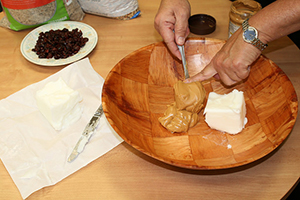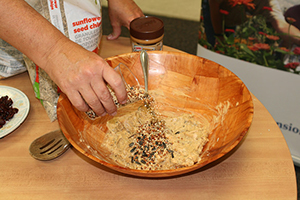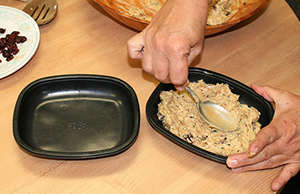DIY Suet

Feeding birds is mutually beneficial—they’re getting a meal while we enjoy watching wildlife. Suet cakes are a great source of high-energy protein for birds in your landscape.
What is suet?
The word “suet” actually refers to a specific type of fat found around the kidneys of cows. Since the use of true suet in cooking has fallen out favor in many areas, the word is often used to refer to any “cake” used in bird feeders; modern suet is often made with store-bought lard. (If you have a butcher shop in your area that can supply you with true suet, this would be the better option, since lard gets softer in the heat more quickly than true suet.)
Suet cakes are placed in a wire cage and hung in your garden where birds can enjoy them. Some of the birds you might see around a suet feeder are woodpeckers and wrens. They are especially popular during the winter, when the bugs that some birds eat for protein are harder to find.
Suet cakes can be left out year-round for birds, although gardeners should be aware that in the Florida heat, suet cakes with a high proportion of animal fat can melt. Be sure to put your bird feeder in a spot where you’ll have a good view of all the activity. As with any bird feeder, place it at least 10 to 15 feet away from trees to help keep squirrels at bay.
Making your own
While suet is readily available pre-made at many gardening stores, some people prefer to make their own. Making your own allows you to customize what you put into your suet, plus it can be a lot of fun!
You can use a recipe to make suet—many can be found online—or you can wing it, like we did. For our suet we used lard, peanut butter, bird seed, chopped sunflower seeds, and raisins. Some recipes call for oats, cornmeal, or even coconut. You can play around with what you add and see what the birds in your yard respond to best.
Mix equal parts of lard and peanut butter; we used one cup of each. If the lard isn’t soft enough to mix, try microwaving it for 10 to 20 seconds to soften it up a bit.
Add and incorporate the sunflower seeds to the mixture, we used a small party cup to measure out sunflower seeds. Next work in the birdseed and then add the raisins.
Once all of the ingredients are incorporated, refrigerate your suet cakes for about 24 hours so they can harden up. If you’re making a large batch, a baking dish makes a great container for refrigerating your suet. Since we made a small batch, we used some old microwave dinner trays we had laying around. Each tray was the perfect size for individual cakes, eliminating the need to cut cakes out as you would if you used a large pan.
You can see more photos in our step-by-step album on Flickr.
Have a pinecone handy?
While you have all these ingredients out, you can make an even quicker and easier bird feeder using a pinecone. Tie a string around the pinecone and cover it in peanut butter (or a lard-peanut butter combination). Then roll it in birdseed. That’s it!
Now you’re ready to hang your suet and pinecone outside, sit back, and watch the birds enjoy a snack.



